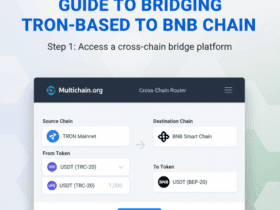In this article, I will discuss the most effective bridging aggregators on Layer 2 networks. These platforms enable the transfer of assets between Ethereum Layer 2 solutions and different blockchains in a faster, cheaper, and more secure manner.
As a DeFi user, NFT trader or developer, familiarity with these top aggregators will enable optimal movement of assets across multiple networks.
How We Pick Best Bridging Aggregators on layer 2 Networks
Supported Networks & Chains – For full interoperability, aggregators need to support Arbitrum, Optimism and Polygon alongside other major blockchains.
Transaction Speed – Cross-chain transfers need to be instantaneous. Almost all top bridges ensure this.
Security – Transfers are considered safe when decentralized smart contracts, bonded relayers, or some sort of validator network are involved.
Cost Efficiency – Users and developers are given prioritized low gas fees and streamlines routing.
Liquidity & Reliability – Users of the aggregators who possess strong liquidity pools are protected from slippage.
Developer Tools – Prior integration support and the availability of SDKs and APIs are major factors.
User Experience – Enhanced usability comes from intuitive cross-chain interfaces, swaps, and comprehensive manuals.
Key Points & Best Bridging Aggregators on layer 2 Networks
| Bridge Aggregator | Key Features |
|---|---|
| Hop Protocol | Optimized for Layer 2-to-Layer 2 transfers; supports Ethereum, Arbitrum, Optimism, and Polygon; offers near-instant swaps with low slippage . |
| Across Protocol | Focuses on secure and efficient cross-chain transfers; supports Ethereum and Layer 2 networks; utilizes UMA Optimistic Oracle for validation . |
| Synapse Protocol | Multi-chain bridge supporting over 15 networks; enables seamless asset transfers; integrates with various Layer 2 solutions . |
| deBridge | Provides cross-chain interoperability for developers; supports Ethereum, Arbitrum, Avalanche, Solana, and BNB Chain; offers low-latency transfers . |
| Celer cBridge | Supports 40+ blockchains; facilitates quick and secure cross-chain transfers; ideal for users seeking decentralized bridging solutions . |
| Portal (Wormhole) | Built on Wormhole messaging protocol; enables cross-chain communication across multiple blockchains; supports token and NFT transfers . |
| Rango Exchange | Real-time liquidity tracking bridge aggregator; aggregates liquidity from multiple chains; offers fast cross-chain swaps with minimal slippage . |
| Jumper Exchange | Aggregates multiple DEXs for optimal cross-chain swaps; monitors liquidity pool data across chains; ensures favorable rates and low slippage . |
| Axelar Network | Provides secure cross-chain communication; supports Layer 2 solutions; facilitates seamless asset transfers across different blockchains . |
| Relay Protocol | Decentralized exchange enabling fast, low-cost cross-chain interoperability; connects over 40 blockchains; supports token bridging and swaps . |
10 Best Bridging Aggregators on layer 2 Networks
1.Hop Protocol
Hop Protocol is among the foremost bridging aggregators on Layer 2 networks, built for quick, safe, and economical cross-chain transfers. It enables connection and near real-time instant swaps between Ethereum and Layer 2 networks Arbitrum, Optimism, and Polygon.
Hop uses smart contract routing and liquidity pools to allow asset movement between chains and avoids the need for long waiting confirmation times. This makes it very suitable for DeFi traders looking for a smooth experience.

Through stringent security policies combined with widespread network integration, Hop Protocol is one of the foremost options for Layer 2 bridging.
| Feature | Description |
|---|---|
| L2 Specialization | Optimized for Ethereum Layer 2 networks like Arbitrum, Optimism, and Polygon. |
| Speed | Near-instant transfers between Layer 2 networks. |
| Cost | Low transaction fees due to efficient routing. |
| Security | Trustless, decentralized smart contracts ensure asset safety. |
| Liquidity | Uses “Hops” liquidity pools to facilitate cross-chain swaps. |
2.Across Protocol
Across Protocol serves as a decentralized cross-chain bridge facilitating transfers from Ethereum to Layer 2 networks such as Arbitrum, Optimism, Polygon, and zkSync. Across Protocol utilizes Uma’s Optimistic oracle with average transaction finality below a minute and for a fee of less than a dollar for every Eth transfer.

Users are granted the ability to specify their desired outcome via intent-based architecture and a network of bonded relayers will guarantee execution.
Across Protocol earns their reputation for speed and security as well as upward scaling in the Layer 2 bridging landscape for having 28 billion in processed volume with no reported exploits.
| Feature | Description |
|---|---|
| Architecture | Optimistic cross-chain bridge using UMA Optimistic Oracle. |
| Liquidity | Single-sided liquidity pools reduce capital requirements. |
| Speed | Fast transaction finality across L1 and L2. |
| Security | Bonded relayers validate transfers securely. |
| Usability | Supports Ethereum and Layer 2 networks efficiently. |
3.Synapse Protocol
Synapse Protocol serves as a primary aggregator for cross-chain bridges, enabling smooth interoperability between networks on Layer 2.
It allows players move assets, make smart contract calls, and transfer NFTs between Ethereum and Layer 2 in Arbitrum, Optimism, Polygon, and zkSync.

Synapse applies optimistic security model, which helps assume transactions valid until proven wrong, thus faster and more secure. The protocol is multi-token and works with many dApps which helps users make efficient cross-chain transactions.
| Feature | Description |
|---|---|
| Multi-chain Support | Connects Ethereum, Arbitrum, Polygon, Optimism, and more. |
| Asset Transfers | Supports tokens, stablecoins, and NFTs. |
| Messaging | Cross-chain communication with low latency. |
| Security | Optimistic security model ensures reliable transfers. |
| Developer Tools | SDKs and APIs available for integration. |
4.deBridge
DeBridge is an advanced interoperability protocol that supports effortless and trustless mobility of data and native assets between numerous Layer 2 networks and blockchains.
Unlike traditional bridges which utilize wrapped tokens or liquidity pools, deBridge uses 0-TVL architecture, which guarantees zero slippage and custody-free risks. It allows real-time execution with instant finality of numerous tokens such as ETH, USDC, SOL, ARB, DOGE, BNB and many others.

deBridge is strengthened by a solid off-chain validator architecture which audits transaction data and ensures no gas costs.
DeBridge is uniquely positioned with more than $12 billion in transaction volumes and with integrations from wallets like MetaMask, TrustWallet, and Phantom. It also offers SDKs, APIs, and cross-chain widgets for decentralized application development which makes DeBridge a developer-friendly solution.
| Feature | Description |
|---|---|
| Native Transfers | Supports zero-TVL native token transfers without wrapping. |
| Speed | Real-time cross-chain execution. |
| Security | Off-chain validators confirm transactions. |
| Multi-chain | Compatible with Ethereum, Arbitrum, Solana, BNB Chain, and more. |
| Developer Friendly | Offers APIs, SDKs, and widgets for dApps. |
5.Celer cBridge
Celer cBridge operates as a cross-chain bridge in a decentralized and non-custodial manner, allowing for rapid and inexpensive transfer of tokens across 40+ blockchains and Layer 2s.
cBridge is built on Celer Inter-chain Messaging Framework which allows for cross-chain interoperability with Ethereum, Arbitrum, Optimism, and Polygon, Avalanche among others.

It allows for cross-chain transfers of tokens such as ETH, USDC, USDT, WBTC, MATIC and AVAX. cBridge employs the use of liquidity pools and the State Guardian Network (SGN) to provide secure and efficient transactions.
cBridge actively maintains over $14 billion in processed cross-chain transfer volume, proving the solution as a trusted option for bridging assets across the blockchain ecosystem.
| Feature | Description |
|---|---|
| Multi-chain | Connects 40+ blockchains including L2s. |
| Speed | Instant finality using the State Guardian Network (SGN). |
| Cost | Low gas fees via optimized liquidity pools. |
| Security | Decentralized, non-custodial bridging solution. |
| Tokens | Supports ETH, USDC, USDT, WBTC, MATIC, AVAX, and more. |
6.Portal (Wormhole)
Portal (Wormhole) operates as a decentralized cross-chain bridge that allows a trust-minimized, quick, and secure transfer of native data assets across several blockchains and Layer 2 networks. It is built on top of the Wormhole messaging protocol which employs a system of cross-chain message validators called Guardians.
These validators ensure cross-chain message integrity, thereby averting compromises on the integrity of transactions. Along with significant networks such as Ethereum and Solana, Arbitrum, Optimisim, and Polygon, over 30 major blockchain networks are supported.

With such architecture, native tokens can be transferred without wrapping, which simplifies the process while enhancing security. Using Wormhole Connect, developers can easily integrate cross-chain asset transfer functions into their apps, as the SDK requires minimal code for bridging assets.
| Feature | Description |
|---|---|
| Protocol | Built on Wormhole messaging protocol. |
| Multi-chain | Bridges Ethereum, Solana, Arbitrum, Optimism, Polygon, and others. |
| Tokens | Supports native token transfers and NFTs. |
| Security | Validated by a network of Guardians. |
| Developer Tools | Wormhole Connect SDK enables cross-chain integration. |
7.Rango Exchange
Rango Exchange stands out as a premier cross-chain DEX and bridge aggregator enabling seamless interoperability across more than seventy blockchains, including Ethereum, Arbitrum, Optimism, Polgon, Solana, Starknet and Cosmos.
It connects to over a hundred DEXs and twenty five bridges allowing the decentralized swap of native assets such as Bitcoin, Ethereum and Matic without wrapping tokens. Rango’s smart routing engine optimizes trades across DEXs and liquidity pools to achieve the best pricing and slippage outcomes.

Besides offering SDKs, APIs and widgets, Rango provides all the needed tools for developers to integrate cross-chain capabilities into their applications. Rango has become a trusted solution DeFi users for cross-chain operations with over $4.85 billion in total volume, $4.85 billion and 6.19 million swaps.
| Feature | Description |
|---|---|
| Aggregation | Aggregates DEXs, DEX aggregators, and bridges. |
| Chains | Supports 70+ blockchains including Layer 2s. |
| Optimization | Smart routing for best swap rates and minimal slippage. |
| Usability | User-friendly interface for swaps and bridging. |
| Developer Tools | APIs and widgets for cross-chain functionality. |
8.Jumper Exchange
Jumper Exchange acts as a cross-chain DeFi aggregator which allows users to swap and bridge tokens with ease on 25 blockchains including Ethereum, Arbitrum, Polygon and Solana.
Jumper Exchange has been integrated with more than 15 bridge protocols as well as over 30 decentralized exchanges (DEXs) which aid in multi-chain asset management.

Jumper’s platform also optimizes trade routing to cross-chain and multi-chain resources to reduce slippage and gas fees. Moreover, Jumper features a gamified Loyalty Pass system boasting user interaction rewards with experience points (XP) which enables exclusive and airdrop access.
Jumper Exchange’s strong platform defenses and easy to navigate interface makes it perfect for well versed DeFi users and new users wanting a seamless cross-chain experience.
| Feature | Description |
|---|---|
| Multi-chain | Supports 25 blockchain networks. |
| Speed | Fast cross-chain swaps with reduced latency. |
| Security | Audited liquidity aggregation. |
| Incentives | Loyalty Pass system rewards users for activity. |
| Usability | Simple interface for both beginners and experienced users. |
9.Axelar Network
Axelar Network is a decentralised interoperability platform that offers cross-chain communication across more than 60 blockchains and includes major layer 2s like Arbitrum, Optimism, Polygon, and Base.
Unlike traditional token bridges, Axelar’s General Message Passing (GMP) Protocol empowers developers to send and receive arbitrary messages and function calls between chains, enabling and simplifying advanced interactions.

This functionality supports DeFi protocols and extends to NFT minting and gaming applications. Cross-chain transactions are secured by a decentralized security model based on proof of stake with 75 validators that guarantees security.
| Feature | Description |
|---|---|
| Cross-chain Messaging | Enables arbitrary function calls and messaging across chains. |
| Supported Chains | 60+ blockchains including Layer 2 networks. |
| Security | Proof-of-Stake validators ensure transaction integrity. |
| Developer Tools | SDKs and APIs for dApp integration. |
| Use Cases | DeFi, NFT minting, gaming, and enterprise applications. |
10.Relay Protocol
Axelar Network is a decentralised interoperability platform that offers cross-chain communication across more than 60 blockchains and includes major layer 2s like Arbitrum, Optimism, Polygon, and Base.
Unlike traditional token bridges, Axelar’s General Message Passing (GMP) Protocol empowers developers to send and receive arbitrary messages and function calls between chains, enabling and simplifying advanced interactions.

This functionality supports DeFi protocols and extends to NFT minting and gaming applications. Cross-chain transactions are secured by a decentralised security model based on proof of stake with 75 validators that guarantees security.
| Feature | Description |
|---|---|
| Multi-chain | Bridges assets across 70+ blockchains. |
| Asset Transfers | Supports tokens and stablecoins. |
| Speed | Low-cost, near-instant cross-chain transfers. |
| Security | Relays transactions through trusted decentralized agents. |
| Developer Tools | APIs and SDKs for building interoperable dApps. |
Conclsuion
To summarize, the most effective bridging aggregators on Layer 2 networks improve cross-chain interoperability, allowing the quick, safe, and economical transfer of assets. Along with Celer cBridge, other bridging aggregators such as Hop, Across, Synapse, and deBridge have tailored solutions
While some other like Rango, Jumper, Axelar, Portal, and Relay focus on advanced developer tools. As with other tools, the choice of the aggregator is determined by the foremost priorities of speed, the number of chains, and security requirements.
FAQ
To save on gas fees, increase transaction speed, and access interoperability between chains.
Hop Protocol, Across Protocol, Synapse, deBridge, Celer cBridge, Portal (Wormhole), Rango Exchange, Jumper Exchange, Axelar, Relay Protocol.
Yes, most use decentralized smart contracts, validators, or bonded relayers for secure transfers.












Got a Questions?
Find us on Socials or Contact us and we’ll get back to you as soon as possible.